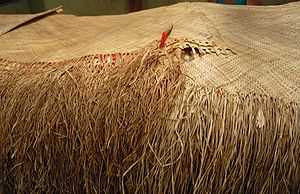‘ie toga

A ʻie tōga is a special finely woven mat that is the most important item of cultural value in Sāmoa. They are commonly referred to in English as "fine mats" although they are never used as 'mats'[1] as they only have a purely cultural value. ʻIe tōga are valued by the quality of the weave and the softness and shine of the material. They are made by women and form an important part of their role, identity and skill in their community.[2]
ʻIe tōga have an unwoven fringe and a strip of red feathers. They are important in gift exchanges during cultural ceremonies and events including matai chief title bestowals, weddings and funerals. In this way, ʻie tōga are passed from family to family, sometimes for many years and are greatly valued. Historically, some ʻie tōga were so valuable they were given their own names. The process of making a fine ʻie tōga can take months of work and have been known to take years. The completion of ʻie tōga can involve a public celebration and presentation with the women parading and displaying their fine mats for all to see.[2]
Cultural value

ʻIe tōga are never used as an actual floor mat in the western sense, functioning only as an item of cultural value. They are considered the most precious item in ceremony and gift exchanges, important in faʻa-Sāmoa. They represent most of the traditional wealth of Sāmoan families. They are exchanged and presented at weddings and funerals, and at special occasions such as the blessing of a newly built fale (house) or the opening of a new church. ʻIe tōga are sometimes worn at special occasions, around the waist, similar to a lavalava. At funerals ʻie tōga are given to the family of the deceased and gifts of mats and food are given in return. These exchanges display a mutual respect that enforces family (ʻaiga) ties.
Process
The best quality of ʻie tōga are made from a variety of long leaved pandanus known as lauʻie. More common types of 'ie toga with a coarser weave are made from laufala, a variety of pandanus which has a darker green colour than the lauʻie plant. The pandanus are grown in village plantations. The long leaves are selected and cut from the plant and taken back to the village. The leaves are prepared by soaking in boiling water followed by drying and bleaching in the sun. Once dry, the leaves are rolled and tied into bundles in preparation for weaving. The long dried leaves are then slit into thin strips for weaving. In the 19th century, young women would start their own mats or complete ones started by older sisters. Today, it is more common for mats to be woven by a group of women working in a fale lalaga (weaving house). The decorative red feathers were originally from Sāmoan or Fijian Collared Lory birds, called "sega," but more modern examples use dyed chicken feathers.
Etymology
The Sāmoan language orthography is not standardized like Tongan language or Hawaiian language in regards to macron ("fa'amamafa") accents and glottal stop ("komaliliu") consonants. Therefore "ie toga" is usually spelled as (Samoa) ie toga" rather than " 'ie tōga" with the accentuated penultimate syllable. Native speakers habitually recognize the proper pronunciation, but given the commonly unaccented spelling "toga" it is common to see the term associated with "Toga," the Samoan spelling of Tonga. Hence the inaccurate explanation that "ie tōga" means "Tongan mat." The actual translation of "tōga" is "treasured" or "valuable" and the term also refers collectively to prestige goods produced by women for ceremonial exchanges. Conversely, men's goods produced for such exchanges were traditionally called "'oloa." This usage is corroborated in Tonga where these types of fine mats are referred to as kie Haʻamoa (Sāmoan mat) and "kie hingoa" ("named mats"), from the Samoan tradition of giving especially precious mats titular names. The Tongan cognate of ʻie tōga is kie tōʻonga," while " 'oloa" and "koloa" are also cognates.
See also
- Ta'ovala, Tongan dress and fine mat.
- Fa'a Samoa, Sāmoan culture and way of life.
- Fa'amatai, chiefly system of Sāmoa.
- Culture of Samoa
- Architecture of Samoa
References
- ↑ Meleisea, Malama (1987). 'ie+toga&hl=en&ei=5em3S4jlOI-2sgOx5s3pDA&sa=X&oi=book_result&ct=result&resnum=8&ved=0CFMQ6AEwBw#v=onepage&q='ie%20toga&f=false The Making of Modern Samoa. University of the South Pacific. ISBN 982-02-0031-8. Retrieved 4 April 2010.
- ↑ 2.0 2.1 Fairburn-Dunlop, Peggy (1998). 'ie+toga&hl=en&ei=V-W3S9ntL4r8tQOb__HCDw&sa=X&oi=book_result&ct=result&resnum=1&ved=0CDYQ6AEwAA#v=onepage&q=ie%20toga&f=false Tamaitai Samoa. University of the South Pacific. p. 187. ISBN 982-02-0137-3. Retrieved 4 April 2010.
- Churchward: Tongan dictionary, 1959